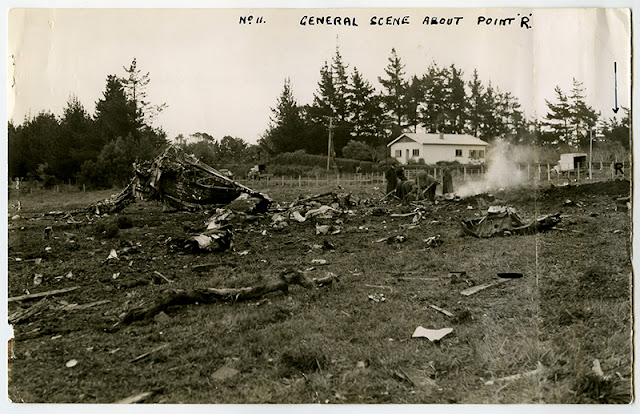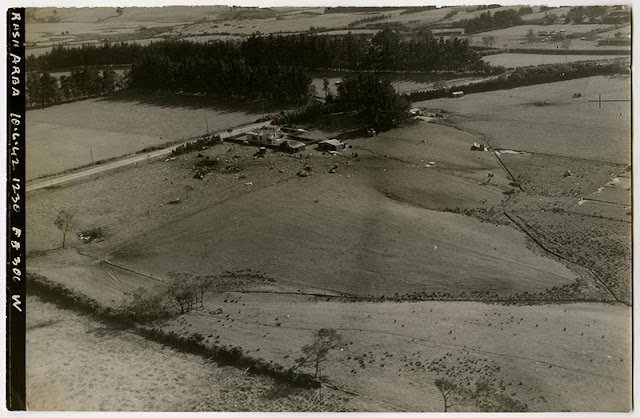 |
| Ten American Servicemen who perished on B -17E Flying Fortress 41-2667 June 9th 1942 were interred in Waikumete Cemetery between these flags. Photo: Cathy Currie |
During the second world war a secret lay buried beneath the clay in this ordinary corner of Waikumete Cemetery. It wasn't until December 1945 that details were finally revealed of the explosion which woke half of Auckland in the dead of night. [1]
Although there was a total censorship
ban to withhold information from the Japanese, there was much talk among the
community, stories were rife with many exaggerating the event, and there were
also accounts that were very close to what had actually taken place. [1]
The USAAF’s Boeing B-17E Flying
Fortress registration number 41-2667 nick named the Texas Tornado, [3] originally
from Hawaii and based on New Caledonia was the first flying fortress to come to
New Zealand. It arrived in Auckland on a secret mission commanded by Colonel
R.E. Cobb, carrying two passengers; an officer of the US Navy and an officer of
the Free French Navy. [3] A few days after its arrival the bomber took off from
runway 21 [2] at the Whenuapai Air Force Base under sealed orders, beneath the
cover of darkness at approximately 12.30am on June 9th 1942. [1][3] The aircraft destined for
Laverton, Melbourne, Australia [3] was flying in a south westerly direction
facing the wind and failed to gain sufficient height striking a low hill on the
Sinton farm at the end of the runway. [1] [3] [4] It burst into flames on
impact and when the fire reached the bomb load just minutes later there was an enormous
explosion [1] as two of the four 500-pound bombs being carried exploded. [3]
A report by the Auckland Star narrates air rescue units being powerless to assist. [1] And all of the 11 on board
perished. [3]
 |
| Wreckage of B-17E Flying Fortress. Archives New Zealand Ref ADQA 17211 AIR1 572 25/2/588 |
It is said that in the official RNZAF report describes the aircraft hitting the ground, bouncing and bellying. At least two occupants survived the initial impact, one was seen dragging another from the burning plane whose body was later discovered in a hedge. The rescuer was attempting to assist another comrade when the bombs went off and he was tragically killed. The other serviceman to make it out was found up the hill and had also died in the explosion. [8]
The bomb blast was so great that the Sinton’s house was knocked off its foundations, injuring Mr. George Sinton, [4] and another nearby house also suffered damage with the occupants narrowly escaping injury. [1]
 |
| Crash site of B-17E Flying Fortress. Archives New Zealand Ref ADQA 17211 AIR1 572 25/2/588 |
A large crater was formed by the
crash [2] and wreckage including engine parts was scattered for miles [1] The
cause of the tragedy was not clearly determined. Had pre-flight aircraft checks been carried out the risk of an accident occurring would have been minimized. [8] Engine failure wasn't evident from witness reports, it was possible that visual distortion occurred when the landing lights
were turned off after taking off from a brightly lit runway resulting in the
pilots being unable to check the altimeter and altitude was lost after
reaching 150 feet. [2] [10] A review the use
of landing lights to assist take off was recommended by the court of inquirey
after the accident. [10]
The remains of the 11 on board
were recovered and the men were interred at Waikumete Cemetery with full
military honours. [2] The funeral service held at Watney Sibuns's chapel on June 12th 1942 officiated by the
Anglican Reverands Rev. E. E. Bamford, and Rev. Father Kevin, 0.F.M., and the Methodist Rev.
W. Walker was attended by American and
New Zealand Service chiefs and personnel as well as the right hon. J.G. Coates,
Mister for the Co ordination of Defense on behalf of the New Zealand
government. [1] A guard of honour formed by 6 officers and 6 men of other ranks
from New Zealand’s Navy and Army also acted as pall bearers. [2] The caskets
were transported to the cemetery by 6 RNZAF trucks from the Kyber Pass funeral
home [4]
Bereaved family had difficulty
obtaining information about what happened to their loved ones as the names of
those on board the aircraft were not recorded before boarding the plane. And desperate
efforts were made for some months by relatives of the victims in America to
obtain the full details surrounding their loved ones’ deaths. With the interest
and cooperation of the Auckland people and approval from military authorities,
information was eventually relayed to them. Mrs Hoffman of Cincinnati the
mother of navigator Lieutenant Hoffman corresponded with an Auckland couple who
sent her all available details and photographs they could find. She obtained
the addresses of the mens’ families from the war department in Washington and
forwarded copies of the letters and photographs from Auckland to them all giving
the bereaved some comfort. Mrs Hoffman was
grateful to receive information from Auckland Star reporter Mr. Geoffrey
Webster about her son's activities with friends and associates in the last
hours before the tragic accident who had met her son Edward at the United
States naval headquarters the night before the crash. [1]
|
|
An area was established at Waikumete Cemetery for America’s war dead in 1943 to which the remains of the men were re-interred on 21st April that year [4] [9] [11] Sometime after the war they were transported to Hawaii and to the United States and laid to their final rest. [1] [2] They are memorialised within Waikumete Cemetery along with the names of another 103 American servicemen who rested here temporarily. [11]
At Whenuapai airfield on November 2nd 1998 a plaque was dedicated to the men. [2]
They were:
0-16724 COBB Richard E - Colonel USAAF - Pilot - 6991+hrs
solo (114+ on B-17)
0-373817 BRUCE James R - Captain USAAF - Co-pilot
0-430049 HOFFMAN E. H - Lieutenant USAAF - Navigator
6267718 LOPEZ J. F - Sergeant USAAF - Flight Engineer
6393791 BRUNSON Charles P - Technical-Sergeant USAAF -
Wireless Operator
7083882 CHILDERS Curtis L - Private USAAF - Gunner
7021855 CLANTON John R - Corporal USAAF - Gunner
6948800 COHN Harry - Sergeant
USAAF - Gunner
13004012 HERRIOTTS James Jr - Corporal USAAF - Gunner
GILBERT Jean Clovis Alexandre - Captain Free French Navy
Liason Officer - Passenger
HURST E W (B W) -Lieutenant
US Navy – Passenger
[3] [4] [5] [8]
According to findagrave.com Arlington National Cemetery, Virginia, USA is the final resting place of Richard
Cobb at section 11, site 537. James Bruce at section 12, site 894. Edwin Hurst
at section 12 site 2853.
And the National Memorial Cemetery of the Pacific
(Punchbowl) Honolulu, Hawaii, the final resting place of Charles Brunson at Plot B Row 0 Grave
958. John Clanton Plot O Row 0 Grave 15 and Curtis Childers at Plot B Row 1
Grave 271.
Joe Lopez is buried at Taft Memorial Park in Taft, Texas, USA. Latitude:
27.9664, Longitude: -97.40507, Harry Cohn is said to be buried at Agudas Israel
Cemetery in Hazleton, Pennsylvania, USA. And James Herriotts is said to be buried at Fern
Knoll Burial Park in Dallas, Pennsylvania, USA.
Jean Gilbert's burial is unknown. [2] Waikumete Cemetery
online burial and cremation database records that his remains were disinterred
from Roman Catholic Division C, R29, P125 on 21st September 1949 for
New Caledonia. After his death he was awarded the Légion d’Honneur (Legion of
Honour). The highest honour awarded for deeds carried out during WW2 bestowed
upon very few individuals or units. He
was awarded the Order of Liberation the second highest honour after the Legion
of Honour [5] 6] and also awarded the Croix de guerre [5] the war cross is a
military decoration usually awarded for acts of heroism. [7]
There are some wonderful images of Jean Gilbert on this link:
FindAGrave - CPT James R Bruce, Jr Originally
interred Waikumete Cemetery, Presbyterian Division E, Row 22, Plot 59
FindAGrave - TSgt Charles Pinckney Brunson, Jr Originally
interred Waikumete Cemetery, Presbyterian Division E, Row 22, Plot 66
FindAGrave - Pvt Curtis Lowell Childers Originally
interred Waikumete Cemetery, Presbyterian Division E, Row 22, Plot 64
FindAGrave - CPL John Robert Clanton Originally
interred Waikumete Cemetery, Presbyterian Division E, Row 22, Plot 65
FindAGrave - Col Richard E Cobb Originally interred
Waikumete Cemetery, Presbyterian Division E. Row 22, Plot 60
FindAGrave - SGT Harry Cohn Originally interred Waikumete
Cemetery, Presbyterian Division E, Row 22, Plot 61
FindAGrave - CPL James Herriotts, Jr Originally interred
Waikumete Cemetery, Presbyterian Division E, Row 22, Plot 67
FindAGrave - 2LT Edward Hall Hoffman Originally
interred Waikumete Cemetery, Presbyterian Division E Row 22, Plot 60
FindAGrave - Lieut Edwin William Hurst Originally
interred Waikumete Cemetery, Presbyterian Division E, Row 22, Plot 68
FindAGrave - TSGT Joe F Lopez Originally interred
Waikumete Cemetery, Presbyterian Division E, Row 22, Plot 63
The
crater at the crash site was quickly filled in after the accident and excavated
75 years later by archaeologists as the site was being prepared for development
and there was a concern that human remains or hazardous materials could be
uncovered. No remains were discovered, and the personal items unearthed are to
be repatriated to the USA. [12]
It has been suggested that the reason for the Flying Fortress visit was to make plans for the soon to be arriving American forces who were to use New Zealand as a post for operations against the Japanese in the pacific. Yet it was not known why the aircraft was carrying a full bomb load on its short flight across the Tasman. [4] It is interesting that the two passengers were notable men and at least 7 of the USAAF personnel on board were attached to the 2nd Provisional Bombardment Squadron. A squadron that seemed to be formed after the Japanese attack on Pearl Harbour which was no longer in existence by September 1942. [8] And curious that a memo from a senior RNZAF officer was attached to a RNZAF report of the crash in the 1980s stating that the information contained in the report should never be publicly disclosed. [8]
It has been suggested that the reason for the Flying Fortress visit was to make plans for the soon to be arriving American forces who were to use New Zealand as a post for operations against the Japanese in the pacific. Yet it was not known why the aircraft was carrying a full bomb load on its short flight across the Tasman. [4] It is interesting that the two passengers were notable men and at least 7 of the USAAF personnel on board were attached to the 2nd Provisional Bombardment Squadron. A squadron that seemed to be formed after the Japanese attack on Pearl Harbour which was no longer in existence by September 1942. [8] And curious that a memo from a senior RNZAF officer was attached to a RNZAF report of the crash in the 1980s stating that the information contained in the report should never be publicly disclosed. [8]
Compiled by Cathy Currie using
the following sources:
[1] When Exploding Flying Fortress Awoke Auckland, Auckland
Star, Volume LXXVI, Issue 302, 21 December 1945
[9] AMERICA'S DEAD, New Zealand Herald, Volume 80, Issue
24506, 12 February 1943
http://paperspast.natlib.govt.nz/newspapers/NZH19430212.2.20
[10]
https://www.flickr.com/photos/archivesnz/34304244914/in/dateposted/
from RNZAF [Royal New Zealand Air
Force] Accident Reports - B 17 Fortress - Usaac 41.2667 - Whenuapai - Crashed,
11 dead - 8 June R21074815 ADQA 17211 AIR1 572 / 25/2/588
[11] New Zealand Cemetery Records.
New Zealand Society of Genealogists Incorporated.
Crash images Archives New Zealand Ref
ADQA 17211 AIR1 572 25/2/588
Cemetery image – Cathy Currie



No comments:
Post a Comment